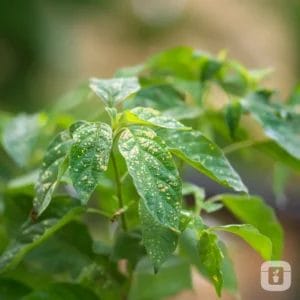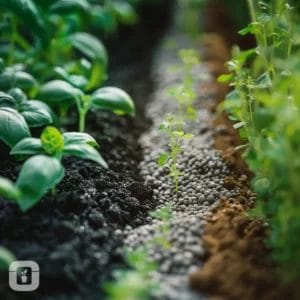
Table of Contents
Introduction to Plant Nutrition

To better understand the nutrition puzzle for plants, you need to understand how the chemical elements and compounds necessary for plant growth work in concert with metabolic processes, and structural development, to deliver the results we are looking for. Unlike animals, plants can synthesize their food through photosynthesis, a process that captures light energy to convert carbon dioxide and water into sugars and oxygen. This remarkable ability not only sustains the plant itself but also forms the base of the food chain for other organisms, including humans.
Definition of Plant Nutrition and Its Importance for Plant Growth
Plant nutrition refers to the needs and uses of the basic chemical elements that plants require to live, grow, and reproduce. These elements are absorbed primarily through the roots from the soil in the form of inorganic ions. The role of these nutrients ranges from contributing to the plant's structural integrity (such as carbon, hydrogen, and oxygen) to playing critical roles in cellular processes and energy transformations (like nitrogen, phosphorus, and potassium).
Adequate nutrition is paramount for the overall health and productivity of plants. It influences various aspects of plant life, including seed germination, growth rates, the strength of stem and root systems, flower and fruit production, and resistance to pests and diseases. Without the proper balance of nutrients, plants can become stunted, fail to thrive, or even die (like this is a surprise for any unlikely gardener), highlighting the importance of understanding plant nutritional needs for gardening and indoor plant success.
Overview of Photosynthesis and How Plants Convert Light into Energy

We talk a lot about light and photosynthesis on the UG Blog, but for those who are new here, photosynthesis is the cornerstone of plant nutrition, enabling plants to capture light energy from the sun (or your trusty grow lights) and convert it into chemical energy stored in glucose, a simple sugar. This process occurs in the chloroplasts of plant cells, where chlorophyll (the green stuff) absorbs light energy. The energy captured initiates a series of chemical reactions that combine carbon dioxide (CO2) from the air with water (H2O) absorbed by the roots from the soil. The result of this process is the production of glucose and the release of oxygen (O2) as a byproduct.
The glucose produced through photosynthesis serves as the primary energy source for the plant, fuelling all its metabolic activities and growth. It can be used immediately, stored as starch for later use, or utilized to synthesize other essential organic compounds, such as proteins, fats, and vitamins, which are vital for the plant's development and reproduction. This process not only sustains the plant but also forms the foundation of most life on Earth, as it is the initial step in the food chain and responsible for the oxygen-rich atmosphere we depend on.
Understanding photosynthesis is crucial for grasping the importance of plant nutrition, as it underscores the need for a healthy environment with adequate light, water, and carbon dioxide for plants to perform this essential function. Additionally, it highlights the significance of nutrient availability, as nutrients are critical for the formation of the enzymes and pigments that facilitate the photosynthesis process.
Essential Nutrients & Their Functions

"You are what you eat" holds as much truth for plants as it does for us unlikely gardeners. Essential nutrients are the building blocks of plant life, each serving distinct roles in supporting growth, development, and overall health. These nutrients are broadly categorized into two groups: macronutrients and micronutrients. Macronutrients, including nitrogen (N), phosphorus (P), and potassium (K), are required in larger quantities due to their integral roles in cellular processes and structural components. On the other hand, micronutrients, such as iron (Fe), manganese (Mn), zinc (Zn), and others, are needed in smaller amounts, yet their impact on plant health is no less critical. They participate in a myriad of biochemical and physiological functions, from enzyme activation to photosynthesis. Understanding the specific roles and importance of these nutrients not only demystifies the process of plant nutrition but also equips gardeners and plant enthusiasts like us with the knowledge to nurture our plants more effectively.
Macronutrients
Nitrogen (N)
Nitrogen is fundamental for plant growth, being a major component of chlorophyll, the compound plants use in photosynthesis to convert sunlight into energy. It is also a key element of amino acids, the building blocks of proteins, which are crucial for the growth and repair of plant tissues. Nitrogen supports rapid vegetative growth, leading to lush, green foliage. However, an excess of nitrogen can inhibit the development of flowers and fruits, demonstrating the need for balanced nutrition.
Phosphorus (P)
Phosphorous plays a pivotal role in energy transfer within the plant, being a part of ATP (adenosine triphosphate), the energy currency of cells. It is also involved in the synthesis of nucleic acids (DNA and RNA), which are essential for genetic information transfer and cell division. Phosphorus supports root development, improves plant strength, and enhances flower and fruit production. A deficiency can result in stunted growth and delayed maturation.
Potassium (K)
Potassium is vital for overall plant health. It regulates the opening and closing of stomata, thus controlling water loss and gas exchange. It is also involved in activating enzymes, synthesizing proteins, and forming sugars and starches. Potassium enhances drought resistance, disease tolerance, and the strength of stems and roots. Signs of potassium deficiency include yellowing of leaf edges and poor growth.
Micronutrients
Iron (Fe)
Crucial for the synthesis of chlorophyll, iron is a component of many enzymes that facilitate electron transport (photosynthesis and respiration). Iron deficiency is common in high pH soils and can cause chlorosis, or yellowing, of the leaves due to insufficient chlorophyll.
Manganese (Mn)
Manganese is involved in photosynthesis, nitrogen assimilation, and the synthesis of some enzymes. It aids in the activation of many enzymes needed for plant growth. Manganese deficiency can lead to chlorosis and interveinal necrosis on young leaves.
Zinc (Zn)
Zinc plays a significant role in growth hormone production and enzyme systems. It is essential for stem elongation and leaf formation. Zinc deficiency can lead to stunted growth and leaf discoloration known as chlorosis.
Copper (Cu)
Copper is important for photosynthesis, nitrogen utilization, and protein synthesis. It acts as a catalyst in chlorophyll formation and is involved in several enzyme processes. Copper deficiency can lead to reduced plant growth and delayed flowering.
Boron (B)
Boron is critical for cell wall formation and stability, nutrient transport, and reproductive growth. It aids in the movement of sugars and the development of fruits and seeds. Boron deficiency can cause brittle foliage, poor growth, and fruit or seed deformity.
Molybdenum (Mo)
Molybdenum is essential for enzyme systems related to nitrogen fixation in legumes and the reduction of nitrates within all plants. It helps in the synthesis of amino acids. A deficiency might manifest as yellowing of leaves and stunted growth, similar to nitrogen deficiency.
Chlorine (Cl)
Chlorine, although needed in very small amounts, plays a role in osmosis, ionic balance, and photosynthesis. It also helps in disease resistance. Chlorine deficiency, although rare, can cause wilting and limited root growth.
Nickel (Ni)
Essential for nitrogen metabolism and urease enzyme function, Nickel is required in very small amounts. Deficiency can lead to urea toxicity.
Cobalt (Co)
Although not required by all plants, Cobalt is essential for nitrogen fixation in legumes and in the functioning of certain enzymes. It plays a role in the overall health of certain plants.
Silicon (Si)
Benefits plant strength and resistance by enhancing cell wall strength, thus providing mechanical support and potentially reducing susceptibility to pests and diseases. Read more on Silicon
Selenium (Se)
While not essential for all plants, Selenium can play a beneficial role in some species, contributing to stress resistance. It's important to note that excessive Selenium can be toxic.
Sodium (Na)
Necessary for some plants, especially C4 and CAM (Crassulacean Acid Metabolism) plants, for specific metabolic processes, though not universally required.
Vanadium (V)
Involved in some plants for nitrogen fixation and growth, though the essentiality of Vanadium is less clear and may not be required by all plant species.
Aluminum (Al)
While generally considered toxic at high concentrations, small amounts of Aluminum can be beneficial to some acid-loving plants by aiding in the uptake of other nutrients.
Calcium (Ca)
Calcium s crucial for plant health, serving as a key component of cell walls and membranes and supporting vital processes like cell division, growth, and enzyme activity. Its role in stabilizing cell structures and facilitating nutrient transport is essential for mitigating stress and disease. Deficiencies in calcium manifest as blossom-end rot in tomatoes and peppers, tip burn in leafy vegetables, and stunted growth, characterized by necrotic leaf margins and abnormal root development.
Magnesium (Mg)
Magnesium is crucial for photosynthesis as the core atom in chlorophyll, aiding in energy production and nutrient absorption within plants. Its deficiency often results in interveinal chlorosis—yellowing leaves with green veins—and, in severe cases, can lead to leaf necrosis and loss. This nutrient's role extends to activating essential enzymes and facilitating the synthesis of ATP, highlighting its importance in plant health and growth.
These essential nutrient highlights each contribute to a different aspect of plant growth and development, underscoring the need for a comprehensive approach to fertilization and soil management. Unlikely gardeners and plant enthusiasts of all stripes should aim to provide plants with a well-rounded diet to ensure vigorous growth, vibrant blooms, and abundant harvests.
Nutrient Deficiencies and Toxicities

Understanding the signs of nutrient deficiencies and toxicities is essential for diagnosing and correcting imbalances in plant nutrition. These imbalances can significantly impact plant health, growth, and productivity. Here's an overview of some common symptoms associated with nutrient deficiencies and toxicities.
Nutrient Deficiencies
- Yellowing Leaves (Chlorosis): Often indicates a deficiency in nitrogen (N), iron (Fe), magnesium (Mg), or zinc (Zn). This symptom can appear across the plant or be localized to certain leaves, depending on the mobility of the nutrient in question. For instance, nitrogen deficiency typically affects older leaves first, as the plant reallocates its limited nitrogen to new growth.
- Stunted Growth: A general symptom that can result from a lack of any essential nutrient but is particularly common with deficiencies in nitrogen, phosphorus (P), potassium (K), and sulfur (S). These elements are crucial for energy production, cell division, and overall plant development.
- Poor Flowering or Fruiting: Often associated with deficiencies in phosphorus, potassium, or magnesium. These nutrients play vital roles in energy transfer, reproduction, and the synthesis of flowering and fruiting hormones.
- Purple or Reddish Leaves: A sign of phosphorus deficiency, where the lack of this nutrient affects the synthesis of sugars and starches, causing an accumulation of anthocyanin pigments.
- Brittle or Distorted Leaves: Can indicate a deficiency in micronutrients such as boron (B) or calcium (Ca), which are crucial for cell wall structure and stability.
Nutrient Toxicities
- Leaf Burn or Scorch: Typically a result of excessive fertilization, leading to high levels of nutrients like potassium or nitrogen. This condition causes the leaf edges to appear burnt or brown, a direct consequence of nutrient burn, often tied to guttation where these salts are left in leaf tissue.
- Salt Accumulation: Excessive fertilization can also lead to a buildup of salts in the soil, which can draw water away from plant roots, causing dehydration and salt stress. Signs include stunted growth, wilting, and leaf edge browning.
- Inhibited Growth: While it might seem counterintuitive, too much of certain nutrients can actually hinder plant growth. Excess nitrogen, for example, can lead to lush foliage at the expense of flowering and fruiting. Similarly, an excess of micronutrients, such as copper (Cu) or zinc (Zn), can interfere with the uptake of other nutrients, leading to imbalances and inhibited development.
- Dark Green Leaves or Excessive Foliage: An indication of too much nitrogen, which encourages leafy growth but can delay flowering and fruiting, affecting the overall yield.
- Root Damage or Burn: High concentrations of fertilizers, especially those rich in salts, can cause root damage, making it difficult for plants to absorb water and nutrients effectively. This condition can severely impact plant health and lead to further nutrient uptake issues.
Recognizing these signs is the first step in diagnosing nutrient imbalances. Once identified, adjustments can be made to fertilization practices, soil pH, and irrigation methods to correct deficiencies or toxicities, ensuring your unlikely plants receive the balanced nutrition they require for optimal growth and health.
Soil pH and Nutrient Availability
The role of soil pH in nutrient availability is a critical aspect of plant nutrition and soil science, directly influencing the health and productivity of plants. Soil pH, a measure of the acidity or alkalinity of the soil, can significantly affect the chemical form of nutrients and their solubility, thereby impacting their availability to plants.
How Soil pH Affects the Solubility and Availability of Nutrients

Soil pH determines the chemical form of many nutrients in the soil, which in turn influences their solubility and how easily plants can absorb them. In general, most nutrients are readily available to plants in slightly acidic to neutral soils (pH 6.0 to 7.0). Outside this range, the availability of essential nutrients can be significantly reduced, leading to deficiencies even when the soil contains adequate amounts of those nutrients.
- Acidic Soils (pH below 6.0): In highly acidic soils, micronutrients such as iron (Fe), manganese (Mn), copper (Cu), and zinc (Zn) become more soluble and thus more available to plants. However, this increased solubility can lead to toxic levels of these micronutrients. Conversely, macronutrients like phosphorus (P), calcium (Ca), and magnesium (Mg) become less available, potentially leading to deficiencies.
- Alkaline Soils (pH above 7.0): In alkaline conditions, the availability of micronutrients decreases, leading to potential deficiencies in iron, manganese, zinc, and copper. Phosphorus also tends to form insoluble compounds and becomes less available to plants. Calcium and magnesium availability, however, can increase in alkaline soils.
Adjusting Soil pH to Optimize Nutrient Uptake

Adjusting soil pH is a fundamental management practice to ensure optimal nutrient availability and uptake. The goal is to maintain soil pH within the range that allows for the best availability of all essential nutrients.
- Lowering Soil pH: For soils that are too alkaline, elemental sulphur, sulphuric acid, or acid-forming fertilizers can be applied to lower the pH. Organic matter, such as peat moss, can also help to acidify the soil over time. These amendments increase the concentration of hydrogen ions (H+) in the soil, making it more acidic.
- Raising Soil pH: Lime (calcium carbonate) is commonly used to raise the pH of acidic soils. Dolomitic lime, which contains magnesium, can also be used if the soil is deficient in magnesium. Applying lime reduces the concentration of hydrogen ions, making the soil more alkaline.
It's crucial to test soil pH regularly using a reputable soil test kit or by sending a sample to a laboratory for a more detailed analysis. This testing provides valuable information on the current pH status and helps guide the amount and type of amendment needed to adjust the pH to an optimal level.
By carefully managing soil pH, unlikely gardeners and plant parents of all sorts can enhance nutrient availability, ensuring that plants have access to the essential nutrients they require for healthy growth and development. This practice, combined with appropriate fertilization and soil amendment strategies, forms the foundation of effective plant nutrition and soil health programs.
Fertilization Practices for Optimal Plant Health
Fertilization is a key aspect of plant care that ensures optimal health and productivity. The approach to fertilization involves understanding different types of fertilizers, adhering to recommended application rates, and selecting the appropriate fertilizer based on specific plant needs.
Types of Fertilizers: Organic vs. Synthetic

- Organic Fertilizers are derived from natural sources, including plant, animal, or mineral origins. These fertilizers release nutrients slowly as they break down in the soil, providing a sustained supply of nutrients over time. Organic options improve soil structure and increase microbial activity, contributing to long-term soil health. Examples include compost, manure, bone meal, and blood meal. They are typically lower in nutrient concentration compared to synthetic fertilizers, requiring larger quantities to achieve similar nutrient levels.
- Synthetic Fertilizers are manufactured products that provide nutrients in a more concentrated and readily available form. They offer the advantage of precise nutrient ratios, allowing for targeted nutrition based on specific plant requirements. However, because they are highly soluble, there's a greater risk of nutrient runoff and potential environmental impact if not used responsibly. Synthetic fertilizers do not contribute to soil organic matter or microbial activity.
Importance of Following Recommended Application Rates
Applying fertilizers at the correct rates is crucial to avoid nutrient imbalances that can harm plant health. Over-fertilization can lead to nutrient toxicity, causing symptoms such as leaf burn, inhibited root growth, and reduced flowering, as noted above. It can also result in excessive nutrient runoff, contributing to environmental pollution. Under-fertilization, on the other hand, can lead to nutrient deficiencies, manifesting as stunted growth, poor yield, and general plant decline. Following the manufacturer's recommended application rates and guidelines ensures plants receive the nutrients they need without the negative consequences of over- or under-fertilization.
Reading Fertilizer Labels (N-P-K Ratios)
Fertilizer labels are key to selecting the right type of fertilizer for your plants. They feature N-P-K ratios, which represent the percentages of nitrogen (N), phosphorus (P), and potassium (K) contained in the product. For example, a 10-10-10 (triple ten) fertilizer contains 10% nitrogen, 10% phosphorus, and 10% potassium by weight.
- Nitrogen (N) promotes leafy green growth and is essential for photosynthesis.
- Phosphorus (P) supports root development, flower, and fruit production, and overall energy transfer within the plant.
- Potassium (K) enhances overall plant health, aiding in water regulation, disease resistance, and enzyme activation.
Selecting the right N-P-K ratio depends on your plants' specific growth stage and nutritional needs. For instance, a higher nitrogen fertilizer may be beneficial for leafy plants and vegetables to promote lush, green growth. In contrast, flowering plants and fruit trees might benefit more from a fertilizer with higher phosphorus content to support bloom and fruit development.
Understanding the different types of fertilizers, following recommended application rates, and knowing how to read and interpret fertilizer labels are all essential practices for successful gardening and plant care.
Don't Buy their Bullshit

One thing to keep in mind when it comes to fertilizer is that fertilizer marketing benefits from people like us buying products that we don't need, or that will make any real difference to our plants or gardens. Plants, unlike us humans with bulging bellies, do not typically indulge in excess. If your soil or plant grow medium is not deficient in anything, adding more does not benefit your plant in any way. Any excess that your substrate cannot hold onto, will typically just be washed away. "Balanced" fertilizers like a triple ten, or triple 20, are never likely to be necessary. In the same vein, plant specific fertilizers like "rose food" or "tropical plant" fertilizers are almost totally an attempt to have you buy overpriced, non-beneficial nutrients for your plants.
Another thing to keep in mind is that plants can't read and don't understand branding. All they care about is the nutrients they are taking in. One highly marketing and overpriced Nitrogen atom is the same to the plant in almost all cases as the Nitrogen atom from the dollar store. At some esoteric level there can be minor differences to growth rates and overall health, but for the vast majority of plant parents, you'll never see any difference at all with your plants. For most purposes, a 3-1-2 ratio fertilizer is about as close to what Mother Nature delivers with natural composting as anything. When in doubt, buy a 9-3-6 and simply dilute it by 3x the water and you save even more money on your nutritional needs.
Fertilizer Tips for Plant Parents
For unlikely gardeners and plant parents at all levels, developing a nurturing environment for your plants involves more than just providing light and water. Understanding the nuances of soil health, nutrient management, and proper watering techniques can significantly enhance your plants' overall health and vitality. Here are some expanded practical tips to help you on this journey.
Regular Soil Testing to Monitor Nutrient Levels and pH

As noted earlier, soil testing is a foundational practice for successful gardening. It provides invaluable insights into the nutrient content and pH level of your soil, enabling you to make informed decisions about fertilization and soil amendments. Soil tests can identify deficiencies in essential nutrients, such as nitrogen, phosphorus, potassium, and various micronutrients, as well as determine whether your soil is too acidic or alkaline for your plants' needs. By adjusting the soil conditions based on test results, you can create an optimal growing environment that supports healthy plant growth. Most experts recommend testing your soil every 1-2 years, or more frequently if you're making significant changes to your garden or have encountered persistent growth problems.
The Importance of Observing Plants for Signs of Nutrient Deficiencies or Toxicities
Observation is a critical skill for plant care. Early detection of nutrient deficiencies or toxicities can prevent minor issues from becoming major problems. Signs of nutrient deficiencies, such as yellowing leaves, stunted growth, or poor flowering, indicate that your plants are not receiving the balanced nutrition they require. Conversely, symptoms of nutrient excess, like leaf burn or unusually dark green foliage, suggest that adjustments need to be made to your fertilization practices. By closely monitoring your plants and responding to these signals promptly, you can address nutritional imbalances before they compromise plant health.
Adjusting Watering Practices to Enhance Nutrient Uptake
Watering practices play a crucial role in nutrient uptake. Both under-watering and over-watering can affect a plant's ability to absorb nutrients effectively. Under-watered plants can suffer from dry soil conditions that limit nutrient solubility, while over-watered plants may experience oxygen-deprived roots that reduce nutrient uptake and lead to root rot. The key is to maintain a consistent moisture level that matches the specific needs of your plants. Implementing practices such as mulching can help retain soil moisture and regulate soil temperature, further supporting nutrient uptake. Additionally, the timing and method of watering (e.g., morning watering at the base of the plant) can ensure that water is efficiently utilized for the best possible growth outcomes.
By incorporating these basic tips into your gardening routine, you can better understand and meet your plants' needs, leading to a more rewarding and successful plant parenting experience. Regular soil testing, vigilant observation, and thoughtful watering practices are all essential components of a holistic approach to plant care that fosters robust health and vibrant growth.
Final Thoughts
Mastering the basics of plant nutrition, understanding the significance of soil pH, adopting appropriate fertilization practices, and implementing practical care tips are fundamental steps towards ensuring optimal plant health. For new plant parents and unlikely gardeners, embracing these practices means not only providing your plants with the essential nutrients they require but also creating a nurturing environment that supports their growth and development.
Regular soil testing, careful observation for signs of nutrient imbalances, and adjusting watering practices to enhance nutrient uptake are key strategies that contribute to a thriving garden. By applying this knowledge and remaining attentive to the needs of your plants, you can enjoy the rewards of gardening—lush foliage, vibrant flowers, and bountiful harvests.
The ongoing journey of plant care is a continuous learning process, where each experience brings you closer to becoming a more proficient and mindful, regardless of how unlikely you initially through you are.
Life is busy. Give Us Your Name & Email and We'll Send You Content.
